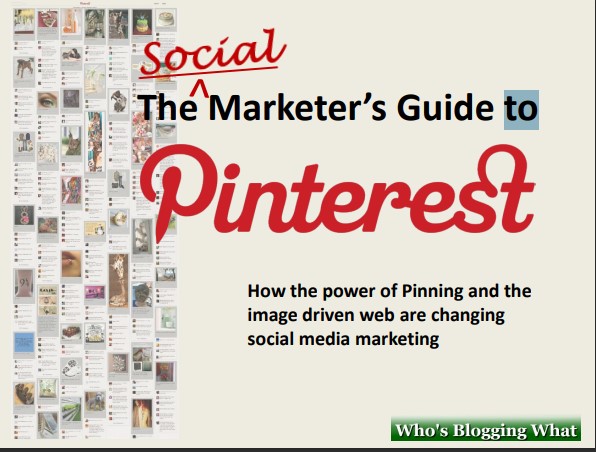The Marketer’s Guide to Pinterest
How the power of Pinning and the image driven web are changing social media marketing
The Marketer’s Guide to Pinterest – In late 2009 short text messages still dominated social media. A three year old startup named Twitter was showing explosive growth built almost entirely on the delivery of short text. Facebook wall posts were still a relatively new form of personal communication.
Advertising campaigns from that spring introduced the phrase “There’s an app for that” but that data speeds for the iPhone and its competitors were still best suited for words, not graphics.
It was in this environment that Pinterest was co-founded by Ben Silbermann, an ex Google product designer and childhood collector of just about everything.
Pinterest was to become an easy to use network where images, not text, would be the primary social currency and that connections would be built from personal interests more so than from pre-existing personal relationships.
Fast forward to 2012 and Pinterest starts out with Nielsen reporting 16 million unique visitors in January alone, with each visitor driving significant ecommerce traffic.
Pinterest has become more than just the hot social media item of 2012. It has opened the door to an entirely new model of social interaction and commerce. The “Power of Pinning” has become a force for all types of online marketers.
How social marketers should look at Pinterest
Pinterest is delivering high volumes of traffic that is already in a product purchasing mindset. Compete analyzed Pinterest’s outgoing traffic and found that:
“Amazon, Ebay, Craigslist, & Houzz are all in
the Top 30 destinations users immediately
visit after Pinterest.com. Target, Walmart, &
Anthropologie are also among the Top 100
destinations“.
A Pricegrabber study of online consumers found that 21% of Pinterest’s rapidly growing user base has made a purchase after seeing a relevant image on the site. The data seem to confirm the logical appeal of Pinterest, where users spend a considerable amount of time browsing product images preselected by other users, all with a link that can be used to track the product back to its source.
The traffic patterns are still evolving and they do not show that Pinterest is an obvious solution for everyone. It is, of course, a highly visual marketplace.
Marketers with products or services that don’t photograph well (or not at all) are experimenting with text and infographics. Multiple studies have shown that the audience is approximately 80% female, distributed fairly evenly throughout the 25-54 age range and well educated.
Remember also that Pinterest is the current media darling and is still very much a work in progress. The Pricegrabber study also found that only 58% of consumers surveyed did not have a Pinterest account and 89% of that subset had no plans to get one.
Establishing a presence
Simplicity is both an advantage and a challenge for businesses setting up a home on Pinterest. Unlike Facebook and Google+ there are no specialized business pages (yet) and relatively fewrules to follow.
There is no equivalent of a Facebook ‘custom tab’ and non technical personnel can manage the account entirely on their own. The need for custom written copy is minimal but creative brainstorming can make a big difference.
Pinterest is all about presenting great visuals and the challenge is to do so in a way that stands out to your audience in such a rich environment.
The first step is to request an account since Pinterest is still an invitation only site (approval usually takes a few days). Use the same email account that is registered at other social networks to facilitate account linkage. Twitter currently works better than Facebook for linking because Facebook currently defaults an email address to a personal account and not a business Page.
The streamlined profile is easy to fill out with an image, short
description and link. It is always important to remember that
search engines as well as people will read the profile. There are
options for linking to Twitter and Facebook but, again, not to a
Facebook business Page.
The atomic unit of Pinterest is the Pin which is a single image or video that has either been curated from a web site or directly uploaded. If it is from a web site it will include a link back to the source.
A pin is accompanied by a text description. While lengthy (500 character) descriptions are technically allowed in practice it is more effective to provide a shorter caption. Users can add their comments and the original Pinner can respond.
Multiple pins are grouped into Boards, and this is where creative thinking can really make a difference. A Board can be dedicated to specific products or lines, it could show customers, behind the scenes activities or anything else that might be eye catching to customers and prospects.
Read Much More Inside…
![]() What’s in a Pin?
What’s in a Pin?
![]() Building Followings
Building Followings
![]() Getting Pinned
Getting Pinned
![]() Working With Pinterest Traffic
Working With Pinterest Traffic
![]() Pinterest tools
Pinterest tools
![]() The Problems of Pinning
The Problems of Pinning
![]() The Power of Pinning
The Power of Pinning
![]() The Future of Pinning
The Future of Pinning
Don’t Miss Out Grab Your Copy Now and Learn to Use Pinterest the Right Way!
Only $7

Click on the Blue Button Below for Instant Access!
![]()
Your name and email will Never be shared, sold, or given to anyone.
Regards, Coyalita
Copyright © 2021 – 2023 U.S.A. Ads Coyalitalinville.com All Rights Reserved Privacy Policy – Earnings Disclaimer – Terms of Use – Contact Us
